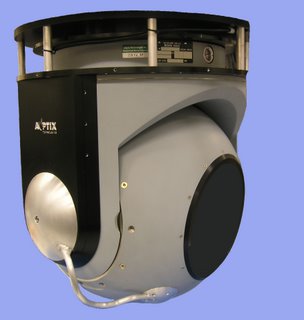Tuesday, March 18, 2008
Laser links: the foundation of future broadband tactical networking

Posted by John Keller
ORLANDO, Fla. -- I think it's obvious that laser crosslinks represent the future of military tactical networking on land, at sea, and in the air. Laser communications are fast, difficult to detect or intercept, and represent bandwidth broad enough to handle the demands of image-intensive real-time intelligence, surveillance, and reconnaissance.
Laser communications, moreover, are not limited by the factors that burden RF-based wireless networking: limited bandwidth, dwindling spectrum, and relatively easy detection. RF tactical networking also must conceal itself from would-be jammers and eavesdroppers by technically demanding means of encryption, frequency hopping, and spread-spectrum transmissions.
Let's face it, however, laser communications are difficult. This technology can be limited by smoke, dust, and clouds. Perhaps more importantly, its laser beams can be attenuated and distorted by atmospheric disturbances. Aircraft have been particularly difficult because their motion makes it difficult to keep a laser beam focused and on target.
Many of these problems may be on the way to solution, however, with a company called AOptix Technologies Inc. in Campbell, Calif., which has come up with an adaptive optics system called R3.1 Skyball that can compensate for atmospheric distortion and aircraft motion such that high-speed laser networking on land, at sea, and in the air suddenly becomes feasible.
AOptix is demonstrating the Skyball system this week at the SPIE Defense & Security conference and trade show in Orlando, Fla.
Short range, AOptix experts have tested the system sending data at 800 gigabits per second. At long range, they have demonstrated the system at distances as far as 93 miles (150 kilometers) at 40 gigabits per second.
Think of it; 40 gigabits per second is faster than many of your laptop computers typically can access the Internet wirelessly. What would 800 gigabits per second networking aircraft, ships, and ground stations bring to the table? The U.S. military is pursuing a concept called network-centric warfare. Well, this could be one of the keys.
AOptix officials point out the possibility of moving massive amounts of intelligence, reconnaissance, and surveillance data nearly in real time from platforms like manned and unmanned aircraft, as well as satellites, to tactical command centers.
These command centers, in turn, could quickly process this data, synthesize it into valuable information, and send it back out in real time via laser links to soldiers, sailors, and airmen on the front lines.
Simply put, this could put us well on the way to the ultimate goal of getting the warfighter the information he needs, just when he wants it. Terrestrial laser communications links. Sounds like the future to me.

Posted by John Keller
ORLANDO, Fla. -- I think it's obvious that laser crosslinks represent the future of military tactical networking on land, at sea, and in the air. Laser communications are fast, difficult to detect or intercept, and represent bandwidth broad enough to handle the demands of image-intensive real-time intelligence, surveillance, and reconnaissance.
Laser communications, moreover, are not limited by the factors that burden RF-based wireless networking: limited bandwidth, dwindling spectrum, and relatively easy detection. RF tactical networking also must conceal itself from would-be jammers and eavesdroppers by technically demanding means of encryption, frequency hopping, and spread-spectrum transmissions.
Let's face it, however, laser communications are difficult. This technology can be limited by smoke, dust, and clouds. Perhaps more importantly, its laser beams can be attenuated and distorted by atmospheric disturbances. Aircraft have been particularly difficult because their motion makes it difficult to keep a laser beam focused and on target.
Many of these problems may be on the way to solution, however, with a company called AOptix Technologies Inc. in Campbell, Calif., which has come up with an adaptive optics system called R3.1 Skyball that can compensate for atmospheric distortion and aircraft motion such that high-speed laser networking on land, at sea, and in the air suddenly becomes feasible.
AOptix is demonstrating the Skyball system this week at the SPIE Defense & Security conference and trade show in Orlando, Fla.
Short range, AOptix experts have tested the system sending data at 800 gigabits per second. At long range, they have demonstrated the system at distances as far as 93 miles (150 kilometers) at 40 gigabits per second.
Think of it; 40 gigabits per second is faster than many of your laptop computers typically can access the Internet wirelessly. What would 800 gigabits per second networking aircraft, ships, and ground stations bring to the table? The U.S. military is pursuing a concept called network-centric warfare. Well, this could be one of the keys.
AOptix officials point out the possibility of moving massive amounts of intelligence, reconnaissance, and surveillance data nearly in real time from platforms like manned and unmanned aircraft, as well as satellites, to tactical command centers.
These command centers, in turn, could quickly process this data, synthesize it into valuable information, and send it back out in real time via laser links to soldiers, sailors, and airmen on the front lines.
Simply put, this could put us well on the way to the ultimate goal of getting the warfighter the information he needs, just when he wants it. Terrestrial laser communications links. Sounds like the future to me.
Comments:
<< Home
The main issue with laser communications is absorption/range and air to ground communications. air to air involves mainly voice and data. Ground to air has more imagery.What is needed is both an adaptive optics and adaptive frequency system to address the ground to air link.
Post a Comment
Subscribe to Post Comments [Atom]
<< Home

